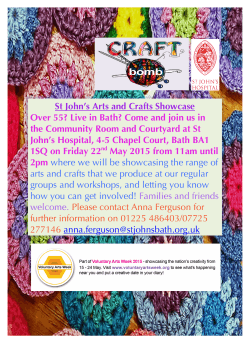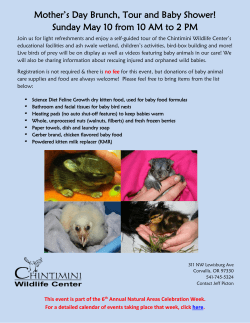
Peace, Baby Activity Guide
A Teacher’s Guide for Peace, Baby! Chronicle Books, 2013 ISBN: 978-1-4521-0613-7 By Linda Ashman Illustrated by Joanne Lew-Vriethoff Summary: PEACE, BABY! is a tale about intense feelings, compassion, conflict, and resolution. Gentle, clever rhymes illustrate the unpredictable emotions of childhood and show readers a smart way to deal with these feelings. A frustrating day may feel overwhelming, but everyone wins with PEACE, BABY! “Excellent advice in a sweet and easy-to-swallow package.” Kirkus Pre-Reading: Introduce the main ideas of the story by asking your students questions. For example, based on the cover, what do you think this book is about? What sorts of situations make you angry? What do you do when you get mad? Do you ever yell or hit? How do you feel afterward? What helps you calm down? Linda Ashman is the author of many critically acclaimed books for children. Her books have been included on the “Best of the Year” lists of The New York Times, Parenting and Child magazines, New York Public Library, Bank Street College of Education, the IRA/CBC and others. As a children’s poet, she’s been compared to Mary Ann Hoberman, Douglas Florian, and Jack Prelutsky; Kirkus called her poetry “as pithy and clever as Ogden Nash at his best.” She lives in Chapel Hill, North Carolina, with her husband, son, and their two dogs. For more information, visit www.lindaashman.com. (Photo credit: Amy Stern Photography, Chapel Hill, NC) Joanne Lew-Vriethoff has illustrated several picture books and novels for children and she collects children’s books. She drew on everything as a child, including her clothes! She grew up in Los Angeles, California, graduated from the Art Center College of Design in Pasadena, California, and now lives in Amsterdam with her husband and two children. Visit Joanne at www.joannelewvriethoff.com. Teacher’s Guide written and designed by Anna J. Boll. http://annajboll.com/creative-curriculum/ chroniclebooks.com/peacebaby Art © 2013 by Joanne Lew-Vriethoff 1 Reading Literacy: Linda Ashman, the author of PEACE, BABY! uses a refrain and rhyme to engage children in the reading experience. Refrain: A refrain in a picture book is a little like a chorus in a song. In PEACE, BABY! the refrain is the phrase “peace, baby.” As you read aloud, cue the students to say “peace, baby” along with you by elongating the word before the refrain and holding up the two-finger peace sign. Children have a tendency to outdo each other’s volume in a choral reading. Ask them to whisper the words “peace, baby” and model that in your own recitation. Rhyme: The author of PEACE, BABY! includes three rhyming lines before the refrain. Point this out to the students and have them identify the rhymes in each stanza. The following rhyming words are used in the book: bed, head, bear, chair, street, feet, gown, crown, snack, back, flat, hat, shout, pout. Write these words on index cards or sentence strips. Add to the pile with rhyming pairs that your students brainstorm (cat/bat, sack/tack). Depending on the number of students in your class, distribute the word cards to students individually or in pairs. Teacher’s Guide written and designed by Anna J. Boll. http://annajboll.com/creative-curriculum/ chroniclebooks.com/peacebaby Art © 2013 by Joanne Lew-Vriethoff Guide Written & Designed by Anna J. Boll 2 Reading Literacy continued: 1. Help the students read their word, focusing on the end phonetics. Note that words do not have to be spelled the same to sound the same. 2. Allow them to draw a picture that helps them remember the word. This could be difficult with more abstract words such as back, flat, or pout. Feel free to substitute words from your rhyming pairs brainstorm. 3. Help each child find the other person in class who has his or her rhyming word. 4. Read PEACE, BABY! aloud and encourage the children to listen for their word. When they hear it, they can stand or hold up their word. You may choose for the first of the rhyming pair to stay standing until his or her partner rhyme stands up. This will reinforce the rhyme. 5. Redistribute the words and repeat some or all activities. Line time is rhyme time: If your class is lined up and waiting, play a rhyme game. Have the line leader think of a word. The following children each get a chance to rhyme the first word. Go through the line rhyming until no one can think of another rhyme. Get your new word from the next child. Make sure the students know that it is okay to “pass,” so they don’t feel pressure to volunteer a word. *TIP: If you have a tech savvy volunteer, ask her to scan the book into a digital slide show. This takes the “big book” concept one step further. The book can be projected onto a smart board or screen as you read aloud and point out the rhyme and refrain, allowing the students to follow the left to right movement of text and story and images. Teacher’s Guide written and designed by Anna J. Boll. http://annajboll.com/creative-curriculum/ chroniclebooks.com/peacebaby Art © 2013 by Joanne Lew-Vriethoff 3 Visual Literacy: Color: The illustrator, Joanne Lew-Vriethoff, chose her color palette to match the mood of the story. What types of colors does the illustrator use? Are the colors soft and pale, or bright and vivid? Show the page “Peace to father.” Point out the difference between the truer, brighter orange and yellow of the flames as compared to the orange and yellow throughout the book. White Space: Often, the “peace” pages have less detailed backgrounds. Instead, the illustrator uses pale colored shapes such as clouds, balloons, and hearts to frame the peaceful action. Lew-Vriethoff has also left a lot of white around the image. This white space allows the reader’s eye to rest and actually feels more peaceful compared to the previous “conflict” page. Show your students spreads six and seven (Lola grabs…), eight and nine (Taj is losing…), twelve and thirteen (Sofie, racing toward…) and sixteen and seventeen (Omar stumbles…). See if they notice this pattern and teach them the term “white space.” Focus: Even though there are many characters in the book, the illustrator has chosen to follow one child, the girl with the blond hair, throughout the whole book. (At the beginning she is in a pink night gown; for the rest of the book she is in a purple dress with spots.) Ask your students to find her as you read. Is she on each page? What is she doing? Is she the focus of the illustration or is she in the background? When she isn’t shown on the page who has become the focus? Teacher’s Guide written and designed by Anna J. Boll. http://annajboll.com/creative-curriculum/ chroniclebooks.com/peacebaby Art © 2013 by Joanne Lew-Vriethoff Guide Written & Designed by Anna J. Boll 4 Visual Literacy continued: Art Activity: Ahead of time, prepare framing devices made from a piece of white paper with an ellipse or rectangle cut out of the middle. Make some of the cuts larger, and some smaller, some square, some elongated. Ask the students to draw a picture of a calm scene. Give them a choice of frames and allow them to move it around the picture noticing how the orientation of the frame, and its placement on the page can change the focus of the drawing. Notice how the new white space creates calm for the eyes. Teacher’s Guide written and designed by Anna J. Boll. http://annajboll.com/creative-curriculum/ chroniclebooks.com/peacebaby Art © 2013 by Joanne Lew-Vriethoff 5 Emotional Literacy: PEACE, BABY! promotes sharing, communication, and generosity to resolve conflict. Sharing Detectives: Cue the students that they are going to be “Sharing Detectives.” Ask them to notice places where the children in the book share. If they see sharing, they should put their peace fingers in the air. Pause when the students raise their hands, and look at the “sharing” spreads together. (These include the spreads that begin: Lola grabs, Taj is losing, Dress up, Sofie racing, One big cookie.) • Teach reading comprehension by asking: What are the children in the book arguing about? How do they share? How were the children in the book able to make peace? • Encourage critical thinking by asking: What would you do in the same situation? “...Use your words— not your feet.” Revisit your own class guidelines. How do you encourage students, who are just learning to communicate, to “use your words— not your feet”? Help students be more aware of how they feel when entering class by asking them, “What kind of day are you having?” or “How are you feeling today?” Encourage students to respond in a variety of ways: • • • • • Verbally. By drawing a picture. With a color card (green, yellow, red). With a temperature (cool, warm, hot). With a feeling face card (index cards with pre-drawn faces). Teacher’s Guide written and designed by Anna J. Boll. http://annajboll.com/creative-curriculum/ chroniclebooks.com/peacebaby Art © 2013 by Joanne Lew-Vriethoff Guide Written & Designed by Anna J. Boll 6 Emotional Literacy continued: Create a place in your classroom where students can write, draw, or breathe (see Activity Extensions below) to regroup when they feel hot or angry. When a student feels calm, he may find the words he needs to talk with others. Peace Bear: Sharing and calm communication require a generosity of spirit that adults can model for children. Designate a stuffed toy as the classroom “peace bear” and allow the bear to spend each day with one child. You can rotate this honor on a regular schedule or use it to highlight positive and peaceful behavior. To give all students a chance to recognize peaceful behavior, please see the Peace Bear Art activity at the end of this guide. “Peace to bugs beneath your feet.” Peace goes beyond child to child encounters to include many other living creatures. Sometimes we are so busy that we forget how much goes on beneath our feet. Outside, mark off an area that is one yard square and have the class sit in a circle around that area. (Note: If you have enough adult supervision, you could mark off multiple one-foot square areas for pairs of students instead.) Ask the students to quietly observe that small area of ground and pair share what they saw. Then the pairs can share with the group. Ask: Are the bugs beneath our feet busy too? What did you observe? What surprised you? Do we have anything in common with these bugs? Try similar activities with the focus on “feathered friends and furry creatures.” Teacher’s Guide written and designed by Anna J. Boll. http://annajboll.com/creative-curriculum/ chroniclebooks.com/peacebaby Art © 2013 by Joanne Lew-Vriethoff 7 Activity Extensions: Yogic Breathing: “When you want to push and shout, hoot and holler, punch or pout, breathe in slowly. Let it out…” Traditional yoga has at its core the practice of pranayama or breath work to stimulate and move energy within the body. When young children focus on their breath it can help with relaxation and allow them to focus their energy on resolution instead of conflict. Below are two types of breathing exercises that you can use with children to increase awareness and relaxation. Balloon Breath: Many of us take very shallow breaths into the chest. Deeper breaths increase the flow of oxygen to our body and brain. Have the students lie down on their backs. Place a small stuffed animal on each child’s belly. Talk them towards a deeper method of breathing by describing the belly as a balloon. Ask them to gently inhale through the nose and blow up the balloon, giving the stuffed toy a “ride” on the balloon. Remind them to exhale gently and try the exercise again, encouraging slow deep breaths to find quiet and stillness. Lion Breath: Are you mad as a lion? If a child is agitated, she might be holding her breath. Join her in taking a series of lion breaths. Kneel on the floor and put your hands on your knees. After inhaling deeply, exhale with a distinct “ha” sound. Your mouth should be wide-open, with the tongue extended as if you are trying to touch the tip of the tongue to the chin. This is a breath that you’ll want to teach to everyone in the class before you use it. Circle-up with everyone kneeling. You may find that a class group of lion’s breath can end up in giggles or roars! Alternately, this can be called “dragon’s breath” and can go with stories that include fire-breathing dragons. Teacher’s Guide written and designed by Anna J. Boll. http://annajboll.com/creative-curriculum/ chroniclebooks.com/peacebaby Art © 2013 by Joanne Lew-Vriethoff Guide Written & Designed by Anna J. Boll 8 Peace Bear Template: Art Activity: Use the reproducible template of the peace bear so that each child can have his or her own bear. Make extras so that during circle time, students can tell about a sharing or peaceful action they saw in class that day and give the peaceful student a peace bear. 1. Copy enough bears for each child onto cardstock or oaktag. 2. Have the students color their bear to make it their own. 3. Cut along the outside of the bear. 4. Glue a tongue depressor onto the backside of the bear to make a handle. Teacher’s Guide written and designed by Anna J. Boll. http://annajboll.com/creative-curriculum/ chroniclebooks.com/peacebaby Art © 2013 by Joanne Lew-Vriethoff 9
© Copyright 2025









